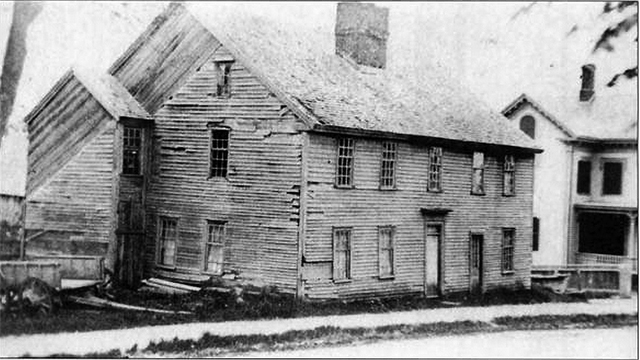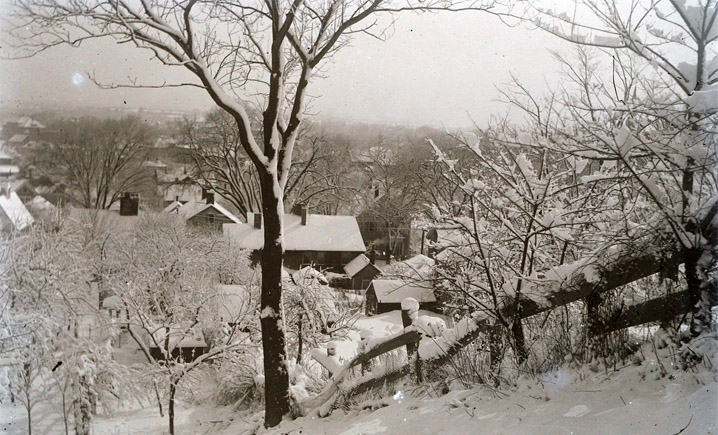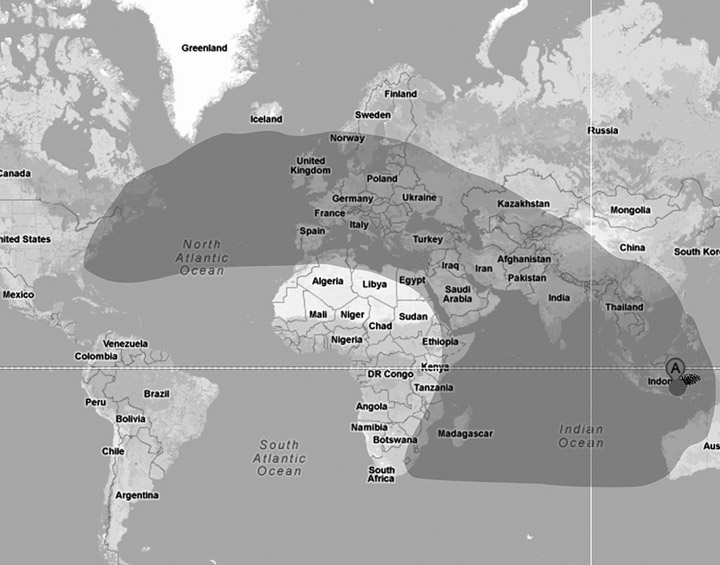Featured image: View from Town Hill by George Dexter, circa 1900
The year 1816 was known as “The Cold Year,” and “The Year Without a Summer.” In our area it was called “Eighteen Hundred and Froze to Death” and “the Summer of Mittens.”
Throughout New England there was frost in every month of the year. The winter had been normal, but in April and May the cold never went away. Trees remained leafless and brown, and oak trees failed to grow at all, deducible from the missing growth ring for that year. Small migratory birds died, their bodies littering the fields. The sky was hazy with a sulfurous tinge.
On June 5, a heat wave raised the temperature in Ipswich to 92° but that afternoon a cold front swept across New England and the temperature fell to 43° by the next morning. For the next four days there were severe frosts along the Eastern seaboard, and snow was recorded in some locations. By the 9th of June ice began to form on water left standing outside overnight. Rapid, dramatic temperature swings continued throughout the summer.
In September there were four severe frosts resulting in the destruction of corn crops. What corn did manage to grow never ripened, and the minimal amount of grain that was raised was eaten, leaving no seed for the next year’s crops. Famine became a threat throughout New England. The price of oats rose from 12¢ a bushel to 92¢ a bushel. Not even enough hay was produced to feed cattle, and farm families survived by slaughtering their livestock. Some villagers in Vermont are said to have survived on hedgehogs and boiled nettles.
In the aftermath of the brutal cold of 1816, thousands of farm families left New England for the Midwest in search of better growing conditions, joining a migration that began when a group of settlers left Ipswich to found Marietta, Ohio in 1787.
The cold summer of 1816 added more misery to an already intolerable economic situation. In 1807 Congress and the President had proclaimed a total trade embargo. By 1809 one-ninth of the population of Salem had become totally dependent on charity, and the situation in Ipswich was similar. The War of 1812 restored the embargo and worsened the attendant misery. The wharves fell into ruin.

Westward migration increased after the winter of 1816, and the population of Ipswich declined. Those who stayed had little money to maintain their homes, and no reason to build new ones, which is, ironically, the reason Ipswich has more surviving First Period houses than any other town in America.
While surrounding towns continued to grow, Ipswich fell into a steady decline. The Salem Mercury estimated the population of Ipswich in 1788 to be 4500 people. The burden of the poor was so great that Chebacco Parish broke away from Ipswich in 1819 and became the Town of Essex. The population in the 1820 Ipswich census was only 2,653 residents. The census of 1830 showed 2961 residents, but in 1837 only 2856 were counted. For several decades the reputation of Ipswich was that it had “gone to seed.” Industrialization in the mid-19th Century eventually reversed that trend, and by 1860 the town had 3,300 residents.
The effect of the cold summer was world-wide and thousands died of starvation in continental Europe. Germans call the following year, 1817, “The Year of the Beggar.” By fall, dry field and forests in northern New England burst into flames, and the sky became so hazy that it was possible to look directly at the sun. Many people for the first time saw sunspots with their own eyes and concluded that they were causing the cold weather. The weather was the constant subject of newspaper articles, and a Salem paper, The Essex Register, famously ran articles using selective data to suggest that the summer was not significantly cooler. Even as the harvest was coming up empty, the Register maintained that “when we settle the year’s account, it will not be the worst ever known.”

The Cold Year is believed to have had two causes. From about 1790 to 1830 the sun was in the Dalton Minimum, a period of low solar activity which caused global temperatures to average about 1°C lower than normal. This was compounded by the 1815 eruption of Tambora on Sumbawa Island in Indonesia, which threw 200 megatons of dust, rock, sulfur and other gases into the stratosphere. The eruption sheared Tambora nearly in half, and 90,000 Indonesians died in the immediate aftermath. The explosion and dust cloud exceeded any volcano in the previous 10,000 years, resulting in a drop in the Earth’s average land temperature between 3°F and 6°F.
Further Reading
- Year Without Summer at the New England Historical Society site
- Munger, The Year Without Summer, published in 2012
- 1816: “The Mighty Operations of Nature” by Michael Sean Munger
- Scientific American: Tambora Erupts in 1815 and Changes World History
- The Dark Day, May 19, 1780


